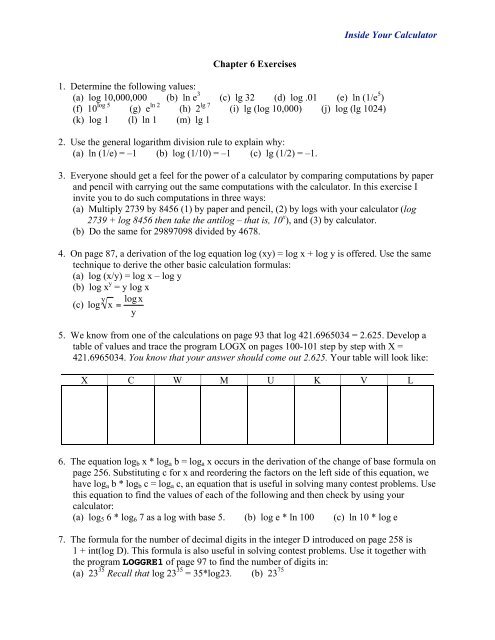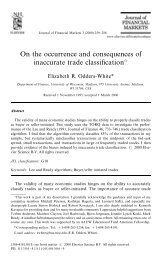Inside Your Calculator Chapter 6 Exercises 1 ... - Acsu Buffalo
Inside Your Calculator Chapter 6 Exercises 1 ... - Acsu Buffalo
Inside Your Calculator Chapter 6 Exercises 1 ... - Acsu Buffalo
Create successful ePaper yourself
Turn your PDF publications into a flip-book with our unique Google optimized e-Paper software.
<strong>Inside</strong> <strong>Your</strong> <strong>Calculator</strong><br />
<strong>Chapter</strong> 6 <strong>Exercises</strong><br />
1. Determine the following values:<br />
(a) log 10,000,000 (b) ln e 3 (c) lg 32 (d) log .01 (e) ln (1/e 5 )<br />
(f) 10 log 5 (g) e ln 2 (h) 2 lg 7 (i) lg (log 10,000) (j) log (lg 1024)<br />
(k) log 1 (l) ln 1 (m) lg 1<br />
2. Use the general logarithm division rule to explain why:<br />
(a) ln (1/e) = –1 (b) log (1/10) = –1 (c) lg (1/2) = –1.<br />
3. Everyone should get a feel for the power of a calculator by comparing computations by paper<br />
and pencil with carrying out the same computations with the calculator. In this exercise I<br />
invite you to do such computations in three ways:<br />
(a) Multiply 2739 by 8456 (1) by paper and pencil, (2) by logs with your calculator (log<br />
2739 + log 8456 then take the antilog – that is, 10 x ), and (3) by calculator.<br />
(b) Do the same for 29897098 divided by 4678.<br />
4. On page 87, a derivation of the log equation log (xy) = log x + log y is offered. Use the same<br />
technique to derive the other basic calculation formulas:<br />
(a) log (x/y) = log x – log y<br />
(b) log x y = y log x<br />
y<br />
(c) log x = log x<br />
y<br />
!<br />
5. We know from one of the calculations on page 93 that log 421.6965034 = 2.625. Develop a<br />
table of values and trace the program LOGX on pages 100-101 step by step with X =<br />
421.6965034. You know that your answer should come out 2.625. <strong>Your</strong> table will look like:<br />
X C W M U K V L<br />
6. The equation log b x * log a b = log a x occurs in the derivation of the change of base formula on<br />
page 256. Substituting c for x and reordering the factors on the left side of this equation, we<br />
have log a b * log b c = log a c, an equation that is useful in solving many contest problems. Use<br />
this equation to find the values of each of the following and then check by using your<br />
calculator:<br />
(a) log 5 6 * log 6 7 as a log with base 5. (b) log e * ln 100 (c) ln 10 * log e<br />
7. The formula for the number of decimal digits in the integer D introduced on page 258 is<br />
1 + int(log D). This formula is also useful in solving contest problems. Use it together with<br />
the program LOGGRE1 of page 97 to find the number of digits in:<br />
(a) 23 35 Recall that log 23 35 = 35*log23. (b) 23 75
<strong>Inside</strong> <strong>Your</strong> <strong>Calculator</strong><br />
(c) Check your answer in (a) by simply entering 23 ^ 35 and examining the answer in<br />
scientific notation.<br />
(d) Why can't you check the answer in (b) by this means?<br />
7. Another use of the binary search technique applied by the program for calculating logarithms<br />
is found in Appendix M. Use the third approach to equation solution by binary search on<br />
pages 253-254 to solve the equation X 5 + 3X 2 "10 = 0. You will need to enter this equation<br />
in the program FN and then enter and run the program BISCH4 of page 254, using the<br />
values P =1 and Q = 2. (This equation was also solved by iteration in Exercise 7 of <strong>Chapter</strong><br />
4. Compare your answers.)<br />
!<br />
8. In Appendix P instructions are given for construction of a table of base ten logarithm values<br />
for the integers 1 to 10. At the end of this Appendix on page 264 suggested factors are given<br />
for the numbers from 11 to 19.<br />
(a) Use these factors to fill in the two digit table of logs.<br />
(b) Extend the table for values from 21 to 25.<br />
(c) Calculate and add values for 35, 45, 55, 65 and 75 to your table.<br />
9. Use the values given in Appendix P and those you have calculated to construct a slide rule as<br />
suggested in this appendix and on pages 198-200 of Appendix C to construct a slide rule. If<br />
possible use a decimal ruler and heavy stock 8 ½" by 11" paper for this task.<br />
(a) Along a longer edge of your paper mark off ten inches.<br />
(b) Multiply the values in the table of Appendix P and exercise 8 by 10 to give you values to<br />
mark off and label them along this line.<br />
(c) Along the opposite edge of the paper construct a similar log rule.<br />
(d) Cut these rules out as suggested in the diagram and use them for C and D log scales.<br />
1<br />
2<br />
3<br />
4 5 6 7 8<br />
910<br />
cut<br />
cut<br />
1<br />
2 3 4 5 6 7 8 9 10<br />
How to mark your rule on 8 ½" x 11" Paper<br />
(e) Use your scales as on page 199 to find the following products:<br />
(1) 25 " 5 (2) 120 " 25 Recall that 120 is the same as 1.2 or 12 on your rule.<br />
(3) 45 " 8 To do this recall that 1 and 10 are the same. You can set the right end of your<br />
rule at 45 and read the product opposite the 8.<br />
!<br />
!<br />
!
<strong>Inside</strong> <strong>Your</strong> <strong>Calculator</strong><br />
10. If possible, find a real slide rule and use it to calculate values like those of Exercise 9 (e).<br />
See how much accuracy you can get using just the C and D scales of such a rule by seeking<br />
the following products and comparing them with calculator answers:<br />
(a) 125 " 35 (b) 75 " 45 (c) 132 " 355 (d) 87 " 87<br />
(e) What do you notice about the accuracy of multiplying the numbers in (c) and (d)?<br />
!<br />
!<br />
!<br />
!
















